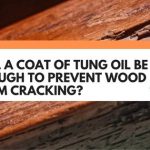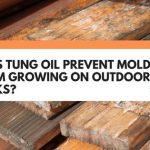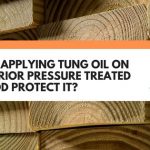You’re just about ready to finish up that MDF workbench, but you’ve decided you don’t want to use varnish or polyurethane to seal it.
Those two finishes are fine options for coating over an MDF countertop. They will even do a decent job at covering over tricky MDF edges. Especially as those edges are prime spots for swelling.
But, if poly and varnish are out, could Tung oil prove to be a good MDF finishing alternative?
Well, in this post, you will learn why oil finishes can pair really well with MDF’s super-absorbent material. You will also discover why pure Tung oil alone may not turn out to be waterproof enough for MDF…
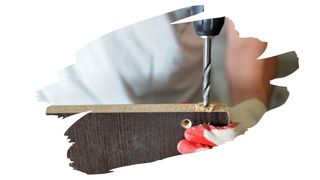
This post may contain affiliate links to products that we receive a commission for (at no additional cost to you). Learn more here.
What Is The Best Type Of Finish For MDF?
Any finish that is oil-based or solvent based can work well on MDF, (also referred to as Medium Density Fiberboard). So, oil-based finishes, sealers and glues can all be used to seal MDF boards.
But, the key thing to remember is to avoid using any kind of water-based finish on MDF. That is because MDF is notorious for water damage. And it will warp and bow if water gets into it.
Water-based sealers and finishes have water in them. And their water-content is the main reason why they dry much faster than their oil based counterparts.
So, if you were to apply water-based finish onto that work bench top, the MDF material will absorb the finish too quickly. Basically, MDF will suck out all of the water before a water-based finish has had time to properly dry and cure.
In fact, this is one of the reasons why you should not use water-based wood glue to fasten MDF. You can learn more about this in our post here: A Quick Guide To Fastening MDF (+ The Best Screws For MDF).
That Means You Can Apply Tung Oil On MDF, Right?
Tung oil will have no problem soaking into MDF, because Tung oil is an oil-based finish, (obviously!). So, MDF doesn’t have a problem with letting this slow-drying finish cure in its own good time.
Is Tung Oil A Permanent Finish? A pure Tung oil finish will need to be reapplied every 6-12 months or so. Otherwise, Tung oil finishes need some kind of durable top sealer if you want this oil finish to really last.
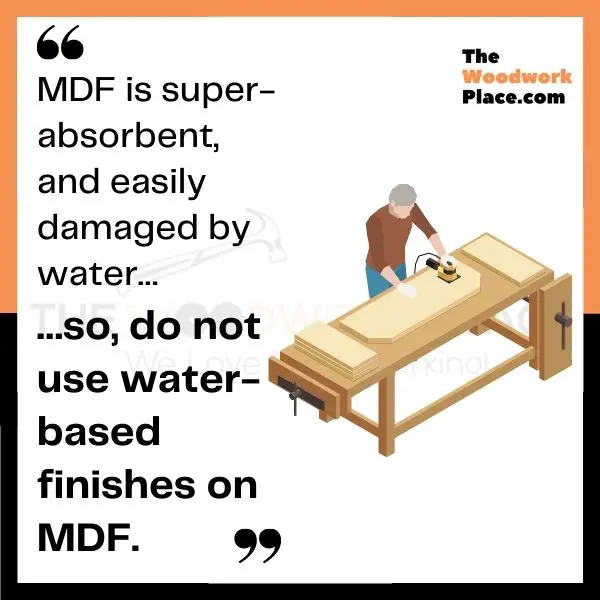
What Is Tung Oil Made From?
Pure Tung oil is extracted from the seeds of Tung trees. And a pure Tung oil wood finish doesn’t have any drying additive ingredients in it.
Which is why a lot of so-called Tung oil products sold today are not Tung oil at all. Instead, they are fast-drying varnish/oil blended products. In fact, many of them don’t even have any Tung oil in them.
However, pure Tung oil is a slow-drying, slow-curing finish that can take up to 30 days to harden and cure. Sometimes, it can take even longer than that.
Related Post: Tung Oil Not Drying? (3 Simple Ways To Fix It)
What’s The Best Way To Apply Tung Oil On To MDF?
Well, pure Tung oil is a very thick finish. So, ideally, you should thin it out with mineral spirits, (1 part Tung oil with 1 part Mineral Spirits), before application.
This will make it easier for Tung oil to sink into MDF. Although, a thinner Tung oil finish will need more coats than usual (around 3-5 coats) for full and proper coverage.
But, Will Tung Oil Make MDF More Durable?
MDF is pretty durable all on its own. Its heavier than plywood, and is even heftier than natural Pine.
It is also an incredibly stable material too, (provided it does not get wet). Which means that, (unlike natural wood), MDF won’t shift around due to mild changes in temperature or humidity.
MDF Is Easily Damaged By Water
MDF does have one major flaw; it soaks up water like a kind of super sponge. This engineered wood easily absorbs liquid more efficiently than raw natural wood.
What’s more, once water gets into MDF, it can really do a number on all of it’s tightly packed wood shavings. Which is why MDF warps and bows so easily in high humidity environments.
So, if you want to make MDF durable, you need to do everything you can to keep it away from water.
Related Post: Why Is My MDF Board Warping? (+ How You Can Fix It)
Tung Oil Is Water Repellent, But It Is Not Waterproof
Now, the thing about Tung oil is that this finish is not 100% waterproof. At best, it is a water-repelling finish that acts more like a wood preservative.
A penetrating Tung oil finish will coat wood fibers/shavings and make them much less water absorbent. Also, it will build up a little on the surface, covering wood with a solid hard resin that is fairly water resistant against the odd spill.
However, this microporous finish is not waterproof. In short, if you apply Tung oil onto MDF it will help make MDF a little more water resistant. However, it does not help improve the overall durability of MDF.
What Is A Microporous Finish? Microporous finishes prevent water droplets and liquids from getting through. However, water vapor can pass through them. Which is why these finishes can get water ring damage from hot cups.
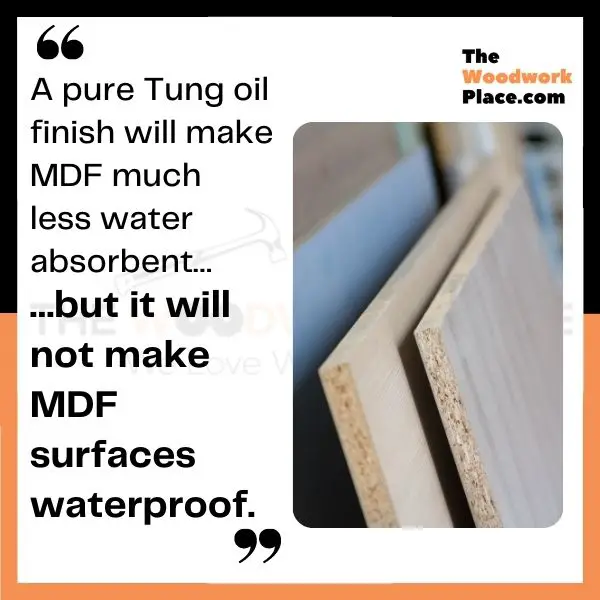
What Can You Cover MDF With (If You Want The Most Durable Finish Possible)?
For the most durable MDF finish, you need the most water-resistant one. In which case, a thick epoxy resin coat will do the best job at keeping water out of MDF.
Related Post: Can You Apply Epoxy Over A Tung Oil Finish?
To Wrap Up, Here Are The 3 Key Takeaways…
- 1). MDF is super-absorbent, and easily damaged by water.
- 2). So, do not use water-based finishes/oils/glues on MDF.
- 3). A pure Tung oil finish will make MDF much less water absorbent. However, it will not make MDF surfaces waterproof.

